A new machine learning trial out of Cornell University divided people with autism spectrum disorder (ASD) into four distinct subtypes based on genetics and clinical symptoms.
The researchers used sophisticated computer modeling algorithms to analyze the brain scans of 299 people with ASD and compare them to more than 900 neurotypical controls. Based on patterns in verbal ability, social affect, and repetitive or stereotypical behaviors, the Nature Neuroscience study classified people into one of four autism subgroups. Each group showed unique biological differences in regional gene expression and protein-protein interactions in the brain.
Two of the groups scored above average for verbal intelligence. The first group demonstrated more repetitive behaviors and less social impairment. The second group demonstrated fewer repetitive behaviors but more social impairment.
The other two groups presented with more severe social impairments and repetitive behaviors. One of these groups had high verbal abilities, while the other had low verbal abilities. Despite some similarities, the researchers spotted differing brain connection patterns that clearly set the two subgroups apart.
Lithium In Drinking Water Linked to Higher Autism Risk
Antenatal and Neonatal Risk Factors in Autism
Buspirone for Comorbid Anxiety in Autism
Based on computer modeling, the brain scans uncovered three latent patterns hiding in the data that helped explain variations in symptoms and behaviors between the four groups. In additional tests, each group demonstrated regional differences in the expression of autism-related gene sets. These gene sets were differentially associated with distinct molecular signaling pathways involving immune and synapse function, G-protein-coupled receptor signaling, protein synthesis, and other processes.
“Like many neuropsychiatric diagnoses, individuals with autism spectrum disorder experience many different types of difficulties with social interaction, communication, and repetitive behaviors,” co-senior author Conor Liston, MD, PhD, an associate professor of psychiatry and of neuroscience in the Feil Family Brain and Mind Research Institute at Weill Cornell Medicine said in a press release.
“Scientists believe there are probably many different types of autism spectrum disorder that might require different treatments, but there is no consensus on how to define them,” he added.
In 2017, the same researchers used similar machine learning techniques to perform an analysis on patients with depression. Here again, they discovered four biologically separate subtypes based on brain pathways and genetics. Follow up work suggested that each of the groups would probably respond differently to various types of depression therapy.
Liston said the most recent study highlighted a new way of looking at autism. He hoped that knowing that there are real neurobiological differences within the same diagnosis could help people with autism make sense of their condition.
Next up, a mouse study that looks at the ASD subgroups to help find potential targeted therapeutics. Liston also said that his team will refine their machine learning models, use larger databases, and collaborate more closely with other researchers.

